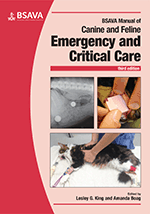
Full text loading...

Fluid therapy is part of the treatment plan in most critically ill animals. The precise type, rate and total volume of fluid to be administered for optimal management of a patient can be difficult to determine. This chapter guides the reader in terms of decision-making and application of goal-directed fluid therapy.
Fluid therapy, Page 1 of 1
< Previous page | Next page > /docserver/preview/fulltext/10.22233/9781910443262/9781910443262.4-1.gif

Full text loading...






